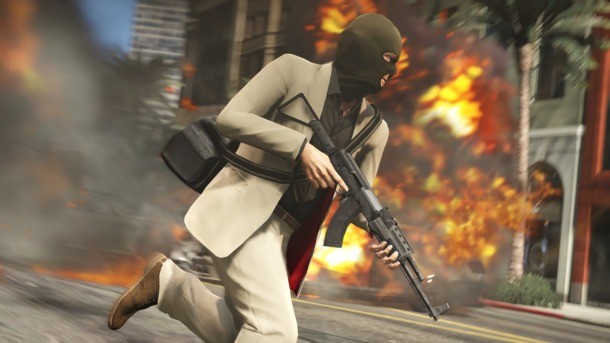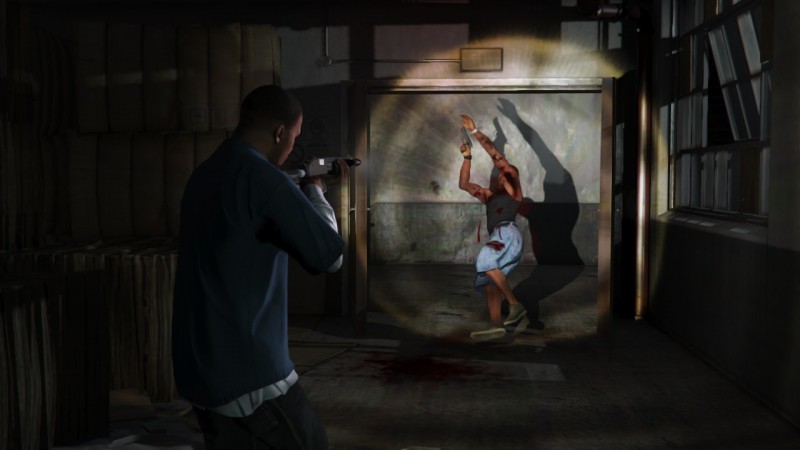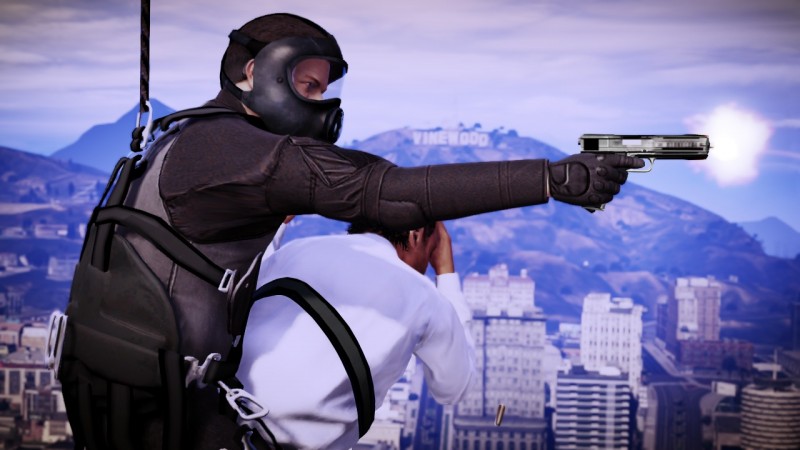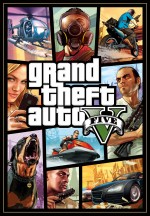Please support Game Informer. Print magazine subscriptions are less than $2 per issue
Grand Theft Auto V

Rockstar Games has a long lineage of best-selling games, but one complaint that frequently recurred in the early years of the Grand Theft Auto series was the lack of fidelity in gun combat. The developer tackled this challenge head-on in moving to current generation of consoles with Grand Theft Auto IV, and has continued to sharpen its aim with Red Dead Redemption and Max Payne 3. Associate technical director and combat designer Phil Hooker explains how Grand Theft Auto V synthesizes the lessons learned in these games to create what Rockstar believes to be the most fluid gunplay system it has made to date.
From the demo we
saw, it looks like Rockstar has made major changes to gunplay. Can you tell us
what's happening?
A massive amount of
work went into overhauling animation systems, targeting, and camerawork to
really open up new opportunities for the player in the kind of freeform,
open-world action shootouts that are the heart of Grand Theft Auto. We wanted
shooting to feel more precise and satisfying while supporting multiple styles
of play. The controls have been expanded, so now in addition to traditional
left trigger "down the sights" aiming, you can also both run and shoot
comfortably while only using the right trigger. This retains the benefits of seeing
your character from the third-person view while keeping the feel much closer to
the range of motion and shooting precision you have in a first-person shooter.
It also opens up opportunities for players to develop their skills in both
single-player and multiplayer, as the more accurate you are while moving
quickly the greater your advantage.
This range of motion and precision is completely new to Grand Theft Auto and it really changes the way shootouts feel. Firing on the run keeps your field of vision open, while the locomotion system adjusts automatically between strafing with your weapon up and the more traditional style of locomotion when you are not actively firing. The additional freedom is great for the kind of chaotic shootouts that emerge when you're out in the open world causing havoc and quickly find yourself heavily outgunned and boxed in.
To make this all work, we added an additional layer to our locomotion system. If you fire your weapon, or become engaged in a fight, your character's bearing changes and your default speed switches from a casual walk to a combat jog, giving you improved mobility as well as a greater sense of urgency. If there's no threat or you haven't been firing, you'll revert back to a relaxed state. The transitions between these states are all handled seamlessly without breaking stride, and your characters always appear aware of their surroundings because they're behaving appropriately. Each character's personality is also reflected in the way they move and handle weapons, whether it's Trevor's aggressiveness, Franklin's swagger, or Michael's efficiency.

Would you say the
gunplay is more similar to GTA IV, Red Dead Redemption, or Max Payne 3?
The best way to
describe the gunplay is that it's evolved through influences of all three
games. It's still GTA-based at its core, but as we've collaborated with other
studios along the way we've tried to bring in all the appropriate parts from
the different projects, from the more advanced cover components and
targeting of Red Dead Redemption to the more fluid transitions in and out of
gun combat from Max Payne 3. The main push for gunplay on GTA V was trying
to make everything as dynamic and fluid as possible, from animation to
targeting to camera behavior - we're trying to push every aspect to the next
level.

Talk us through
the evolution of gun targeting since GTA IV. What is the default setting - hard
lock, soft lock, or free aim? How have each of these settings changed
from previous Rockstar games?
We really wanted to
refine the way the targeting system worked so that outside of free aim, it was
a more subtle form of assistance that was almost invisible to the player and
less of a hard mechanic. Hard lock has gone altogether as we found it too
disorientating and often broke your immersion with the game, as you didn't have
to think about enemy locations. We wanted players to stay in the moment and
think more tactically about firefights.
For GTA V, we've split targeting out into three distinct modes: assisted aiming, traditional GTA, and free aim.
Assisted aiming gives players a larger targeting area as well as a little more help analyzing targets to try and pick the largest threat.
Traditional GTA is the closest to previous GTA's soft lock option. It shares all the characteristics of assisted aiming, with the additional ability to flick left and right between targets using the right stick.
Another new refinement is that every aim mode now has a timer that breaks lock so you have to be more tactical in your approach - you can no longer just rely on holding and shooting until a target is dead.
We've also added other assists to free aim for each of those modes, including help with reticule speeds near targets. We've also spent time making sure the camera movement is smooth so you aren't disorientated by choosing between targets in the heat of a battle. Both of these work in tandem to make the shooting feel fluid without you noticing there's any assistance at all.
In addition to the assisted modes, experienced shooter players should feel more comfortable than ever playing the entire game in free aim.
How has the cover system evolved?
The game at times is all about switching from one character to the next, allowing the player to make fast choices with seamless transitions. We carried this mentality through into the cover system, keeping things intuitive and responsive whether the player is quickly dashing into or out of cover or moving round corners to take aim on a target.
We've also pushed the cover system to further bridge the gap between driving and gunplay. In addition to smoothly running out of a car whilst firing a gun, players are able to use their car as cover, getting out and staying low without exposing themselves. They can make a stand there behind the car for a while and then at any time quickly re-enter the car from cover or from shooting and speed away with little exposure to enemy fire. It can really make the difference at crucial moments.

To read more about our impressions of combat, click here. For an even more in depth look at Grand Theft Auto V, click on our cover story hub below:












